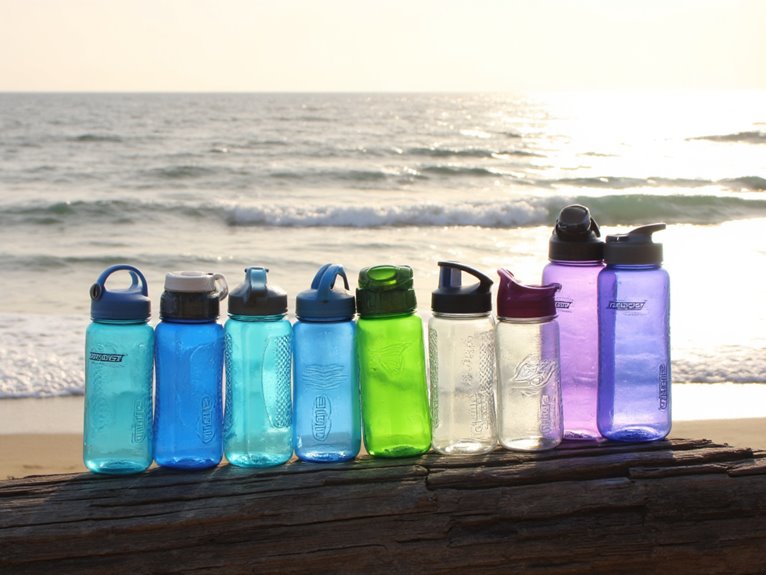Are Inflatable Canoes Any Good?
Inflatable canoes have come a long way in recent years, offering a unique blend of durability, portability, and versatility that makes them a compelling alternative to traditional canoes. They are lightweight, easy to transport, and can navigate various water types with ease. Modern designs prioritize comfort and performance, featuring adjustable seating and skegs for improved tracking. While they may require minimal maintenance and can last for many years with proper care, they do come with some stability and tracking issues. To fully appreciate the benefits and limitations of inflatable canoes, it's essential to examine their performance, durability, and ideal uses in more depth.
We are supported by our audience. When you purchase through links on our site, we may earn an affiliate commission, at no extra cost for you. Learn more. Last update on 28th December 2025 / Images from Amazon Product Advertising API.
Benefits of Inflatable Canoes
Three key advantages of inflatable canoes are their portability, durability, and versatility, making them an attractive option for outdoor enthusiasts.
Weighing much less than traditional canoes, inflatable canoes are easy to transport and store, allowing for spontaneous adventures and convenient travel. Additionally, their compact size enables effortless storage in small vehicles or closets.
The versatility of inflatable canoes is also remarkable, as they can navigate a variety of water types, from calm lakes to whitewater rapids.
Moreover, many modern inflatable canoes are designed with comfort and performance in mind, offering features like adjustable seating and skegs for improved tracking.
Durability and Maintenance Concerns
While inflatable canoes are renowned for their durability, they still require regular maintenance to maintain peak performance and extend their lifespan.
Failure to do so can lead to premature wear and tear, compromising the canoe's overall integrity.
Routine inspections are vital to identify potential issues before they escalate. Check for signs of abrasion, cracks, or punctures, and address them promptly.
Clean the canoe regularly to prevent dirt and grime buildup.
Store the canoe in a dry, protected area when not in use, away from direct sunlight and extreme temperatures.
Performance on the Water
With a well-maintained inflatable canoe, paddlers can now focus on optimizing their on-water experience, where factors such as stability, maneuverability, and speed come into play.
Responsive handling: Inflatable canoes can be surprisingly agile, making them suitable for traversing tight waterways and quick turns.
Decent speed: While not as fast as their hard-shell counterparts, modern inflatable canoes can still achieve respectable speeds, making them suitable for casual cruising or short expeditions.
Efficient paddling: The lightweight and buoyant design of inflatable canoes reduces drag, allowing paddlers to conserve energy and paddle more efficiently.
Optimizing their on-water experience involves examining factors such as stability, maneuverability, and speed.
Stability and Tracking Issues
Despite their many advantages, inflatable canoes can be prone to stability and tracking issues, particularly when traversing rough or windy conditions.
This is due to their lighter weight and higher center of gravity compared to traditional canoes.
As a result, inflatable canoes may wobble or tip more easily, making it challenging to maintain a straight course.
Additionally, the softer hull material can cause the canoe to flex and deform, further compromising stability.
To mitigate these issues, it's essential to choose an inflatable canoe with a sturdy construction, a low center of gravity, and a skeg or fin for improved tracking.
Proper paddling techniques and weight distribution can also help to minimize stability and tracking issues.
Comparison to Traditional Canoes
When comparing inflatable canoes to their traditional counterparts, several key differences emerge.
With regard to durability and weight, inflatable canoes often struggle to match the robustness of traditional canoes, but they more than make up for it with their superior portability and storage capabilities.
On the water, performance differences become apparent, with traditional canoes often excelling in respect to speed and maneuverability.
Durability and Weight
Inflatable canoes boast a substantial advantage over their traditional counterparts regarding durability, with many modern models featuring rugged, puncture-resistant materials that can withstand the rigors of frequent use.
This is particularly evident when comparing the weight of inflatable canoes to their traditional counterparts.
Some key benefits of inflatable canoes regarding durability and weight include:
Lighter construction: Inflatable canoes typically weigh markedly less than traditional canoes, making them easier to transport and maneuver.
Improved resistance: Modern inflatable materials offer increased resistance to scratches, abrasions, and punctures, ensuring a longer lifespan for your canoe.
Reduced maintenance: Inflatable canoes require minimal maintenance, as they are less prone to damage and can be easily cleaned and stored, thereby prolonging their lifespan.
Portability and Storage
The convenience of inflatable canoes extends to their portability and storage, allowing users to easily transport and stow them away, a distinct advantage over traditional canoes that often require more space and effort to maneuver.
Inflatable canoes are lightweight and compact, making them easy to carry on a car roof or in a small storage space.
This convenience is particularly important for those with limited storage options or who need to transport their canoe frequently.
In contrast, traditional canoes are often bulky and heavy, requiring more space and effort to transport and store.
Performance on Water
Stepping into an inflatable canoe, paddlers can expect a surprisingly responsive and agile ride, one that holds its own against traditional canoes in regards to performance on water. Inflatable canoes boast a lightweight design, allowing for increased maneuverability and ease of handling. This is particularly evident when traversing tight turns and narrow waterways.
Three key performance advantages of inflatable canoes:
- Improved tracking: Inflatable canoes often feature a more streamlined hull design, reducing drag and enhancing overall tracking performance.
- Enhanced stability: The flexible, soft-sided design of inflatable canoes provides added stability, making them ideal for beginners or those seeking a more relaxed paddling experience.
- Increased acceleration: Inflatable canoes are often lighter than their traditional counterparts, resulting in quicker acceleration and improved responsiveness to paddling input.
Ideal Uses for Inflatable Canoes
In terms of ideal uses, inflatable canoes excel in specific scenarios.
Their lightweight and portable design makes them perfect for flat water paddling on calm lakes, rivers, and coastal areas.
Additionally, their durability and maneuverability also make them suitable for rapid river running, allowing paddlers to navigate through whitewater with confidence.
Flat Water Paddling
On calm lakes, slow-moving rivers, and tranquil coastal areas, inflatable canoes excel in flat water paddling, providing a serene and peaceful experience for paddlers. The lightweight and buoyant design of inflatable canoes allows for effortless gliding across the water's surface, making them ideal for leisurely paddles or fishing excursions.
Inflatable canoes provide exceptional stability, allowing paddlers to move about the canoe without worrying about tipping.
Inflatable canoes are highly responsive to paddle strokes, making them easy to steer and navigate through calm waters.
Inflatable canoes are lightweight and compact, making them easy to transport to and from the water's edge.
Inflatables are perfect for those seeking a relaxing and enjoyable paddling experience on calm waters.
Rapid River Running
Tackling rapids and whitewater rivers, inflatable canoes showcase their exceptional durability and agility, allowing experienced paddlers to tackle challenging currents with confidence.
Inflatable canoes' flexibility and lightweight design enable them to traverse tight turns and drops with ease, while their rugged construction withstands the forces of turbulent water.
When tackling rapids, the inflatable's soft hull also provides a cushioning effect, reducing the impact of collisions with rocks or other obstacles.
In addition, inflatable canoes' buoyancy and stability keep them afloat even in the most turbulent water.
For experienced paddlers seeking an adrenaline-packed adventure, inflatable canoes are an excellent choice for tackling the most demanding whitewater rivers.
Weighing the Cost and Value
Inflatable canoes offer a unique combination of durability and portability, but their cost varies widely depending on size, material, and features, making it essential to weigh the cost against the value they provide.
When evaluating an inflatable canoe, it's vital to assess the benefits against the investment.
Key factors to evaluate include:
Initial Cost: Inflatable canoes can range from a few hundred to several thousand dollars.
Long-term Savings: While the initial cost may seem high, inflatable canoes require minimal maintenance and can last for many years with proper care.
Convenience and Versatility: Inflatable canoes offer unparalleled portability and storage convenience, making them an excellent choice for frequent paddlers or those with limited storage space.






